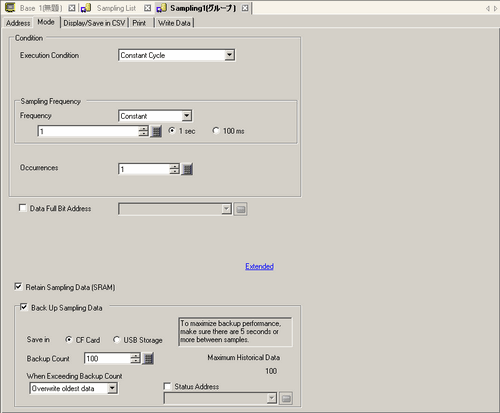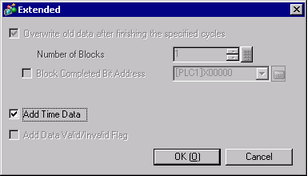![]()
-
If you are using a model that supports SD Cards, change the [CF] and [CF Card] to [SD] and [SD Card].
Sample data at constant cycles starting from when the display unit is turned ON.
![]()
If you are using a model that supports SD Cards, change the [CF] and [CF Card] to [SD] and [SD Card].

Execution Condition
Select the sampling action execution condition. Select [Constant Cycle].
Sampling Frequency
Frequency
Select the sampling frequency from [Constant] or [Address].
When you select [Address], you can change sampling frequency at run time.
Sampling Frequency
When [Frequency]=[Constant], specify the sampling frequency at [1sec] (one second) or [100ms] (one hundred milliseconds).
Set 1 to 65535 when the unit is 1 sec and 1 to 9 when the unit is 100 ms.
![]()
Even when 100 milliseconds is set, the first sample will begin at 1 second.
When [Frequency]=[Address], specify the sampling frequency with a word address.
![]()
You can only set up an internal device address.
Values are read using the decimal (unsigned) format.
If you store a value outside the range supported by the address, operates as follows.
|
[1 sec] / [100 ms] |
Value |
Action |
|---|---|---|
|
[1 sec] |
0 |
Sampling does not occur. |
|
Greater than or equal to 65536 |
Sampling occurs every 65535 seconds. |
|
|
[100 ms] |
0 |
Sampling does not occur. |
|
Greater than or equal to 10 |
Sampling occurs every 900 milliseconds. |
The value in the specified address is cleared (0) on the following timing. To avoid clearing to 0, please use the internal device's backup feature.
![]() 5.4.4.3 Display Unit [Mode] - Backup Internal Device
5.4.4.3 Display Unit [Mode] - Backup Internal Device
When the display unit is turned OFF or reset
On Transfer Project (Automatic transfer)
Going from OFFLINE mode to RUN mode
The defined address is monitored every 50 milliseconds. Checks for changes in value in the specified address before changing the sampling frequency. As a result, there may be a delay in changing the sampling frequency.
Occurrences
Select the number of times sampling will occur. The setting range is from 1 to 65535.
![]()
The setting range is limited by the number of sampling groups and addresses (words) registered in the entire system.
Data Full Bit Address
Select whether to verify the designated number of sampling cycles has completed. If the sampling is one cycle, the specified bit address is turned ON.
The sampling will continue running even when this bit address is ON.
![]()
This address is not turned OFF automatically. In order to verify the next sampling cycle, please ensure that this bit is returned to the OFF state.
Extended
Displays the [Extended] dialog box.

Overwrite old data after finishing the specified cycles
Data will be overwritten and stored, starting with the oldest data, after data has been sampled the designated number of times. This setting is fixed to enable.
Add Time Data
Select whether or not to store the sample time along with the sampled data. If this is not designated, when displaying/saving in CSV or printing, the date/time columns will be blank.
![]()
You must set [Show Cursor] in the [Historical Trend Graph] for Show Cursor to operate.
![]() 19.13.1.9 Historical Trend Graph - Display Historical Data
19.13.1.9 Historical Trend Graph - Display Historical Data
Retain Sampling Data (SRAM)
Select whether or not to save the sampling data to the backup memory (SRAM). If the sampling data is not saved, the data will be deleted when the power to the display unit is turned OFF or reset.
Back Up Sampling Data
Select whether or not to backup sampling data backup memory (SRAM) automatically in external storage when the designated number of sampling cycles is completed. The data is saved in binary format.
![]() 25.12.1 Usage Capacity of Sampled Data
25.12.1 Usage Capacity of Sampled Data
![]()
When selecting this item, precautions on backing up and the maximum number of historical data that can be displayed in the Historical Trend Graph are displayed on the right-hand side. The maximum number is [Occurrences] x [Backup Count].
If you are using the GP4000 Series (except for the GP-4100 Series), the index file "TSAMPINDEX.idx" is automatically created during backups. The display retrieves the data from this file and displays it in the Historical Trend Graph. For more information about index files, please refer to the following.
![]() 19.8.3 Display Historical Data
19.8.3 Display Historical Data
Save in
Select the "Save in" location for backup data from [CF card], [SD Card] and [USB storage].
Folders are automatically created for each sampling group in the "Save in" location. The saved file name will be Time Stamp (year/month/day/hour/minute/second when saved).
For example, when it is saved at 14:30:5 on July 2 in 2007
\SAMP**\T070702_143005#.bin
("**" represents sampling group number and "#" represents index number)
![]()
The index number for file names is from 0 to 9. You can save up to 10 files at the same time.
Backup Count
Specify the number of times (1 to 500) to write the backup data. The number specified here is the number of files that will be created.
When Exceeding Backup Count
Select an action when the number of backup files exceeds the value set in the Backup Count.
Overwrite oldest data
Delete the oldest file and add a new file.
Interrupt Backup
Stops backup. "9" (number of files exceeded) is stored in the status address.
Status Address
Indicates whether the saved operation status and error information are stored in the specified address.

The error status indicates the following error codes.
Error Code
|
Bit 12 to 15 |
Description |
Details |
|---|---|---|
|
0 |
Completed Successfully |
Transfer completed successfully. |
|
1 to 3 |
Reserved |
— |
|
4 |
No external storage |
There is no external storage device inserted into the display unit. The CF Card cover is open. The USB storage is not formatted properly or is damaged. |
|
5 |
Write Error |
The external storage does not have enough free space or the storage was disconnected during write operation. 10 backup data files with the same time stamp already exist because the time setting of the display unit was restored, etc. The SD Card is write-protected. The index file is read-only. (GP4000 Series only) |
|
6 |
Reserved |
— |
|
7 |
CF Card Error |
The CF Card is not formatted properly or is damaged. |
|
8 |
Reserved |
— |
|
9 |
Excess Number of Files |
Exceeded number of files set |
![]()
Even if the error status is saved, retains the save request. The save process runs the moment the error status is released. If the [Data Full Bit Address] turns ON while still in error status, the retained save request is discarded, and the save request for the new backup data is now retained.